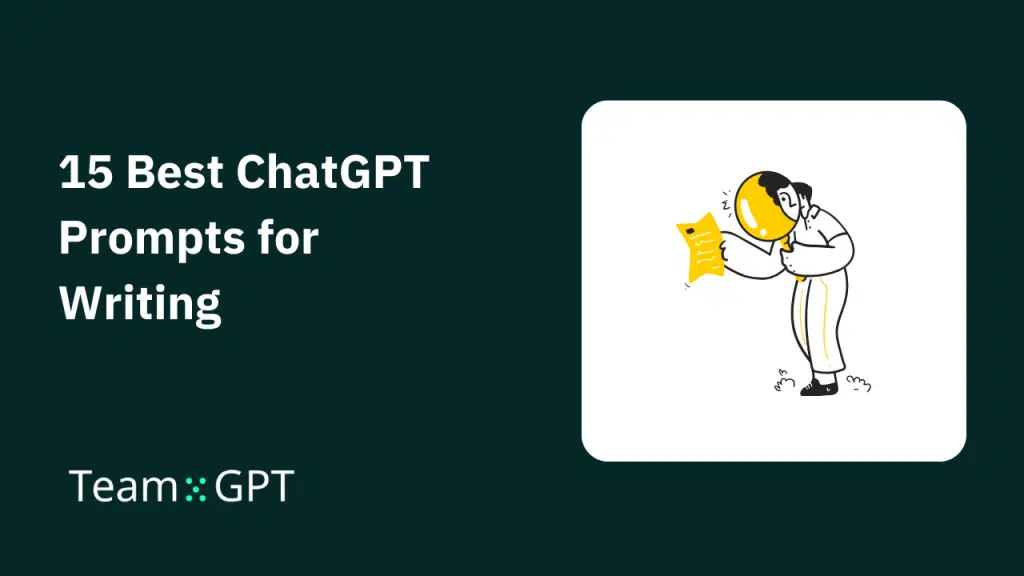According to AuthorityHacker, 85.1% of AI users use the technology for article writing and content creation.
Although a lot of AI content right now is poor quality and spam, some of it is good.
If you give ChatGPT the right instructions and add your human touch to the content that ChatGPT gives, you can produce decent quality content.
In this article, I will discuss the 15 best ChatGPT prompts you can use to up your writing skills.
What are the Best ChatGPT Prompts for Writing?
Writers can leverage the power of ChatGPT in several ways. To discuss the same, I’ve categorized the prompts into four categories:
- Brainstorming ideas
- Research assistance
- Drafting and editing
- Quality check
Every category has two use cases. And every use case has one initial and one follow-up prompt to keep the conversation going.
Category 1: Brainstorming Ideas
ChatGPT can generate a large number of ideas in a short span of time for you to work with. But if you sit and do it manually, it might take a lot of your time.
Apart from this, ChatGPT can also help you overcome writer’s block by generating a stream of ideas.
Let’s see how you can use ChatGPT to get title suggestions and story ideas. 👇
#1. Ask ChatGPT for Title Suggestions
Coming up with catchy titles is never easy.
You must park your main keyword in it while sounding catchy and unique. Sounds like a lot of work? But ChatGPT can help.
ChatGPT is trained on a vast amount of data and topics. Thus, it has a good knack for suggesting blog titles.
It’s unbiased from personal opinions. Hence, it suggests titles from a fresh and objective outlook.
The best part is it never complains about revisions. You can prompt ChatGPT to give title ideas from several different angles and ask it to revise as much as you want.
Prompt:
I plan to write an article on the keyword – landing page optimization.
The article will cover what is landing page optimization, why to do it, best practices, examples, and more.
Can you suggest to me 5 Title ideas for the article?
My primary keyword is landing page optimization, so it must appear in the title as is.
Follow-up prompt:
I like the 4th title you suggested. Can you keep the angle the same and give me more similar title ideas?
#2. Ask ChatGPT for Story Ideas
Leverage ChatGPT’s creativity to draft story ideas for your next book. The tool can weave elements from different narratives, styles, and genres.
From science fiction to fantasy stories – generate multiple versions of any narrative, each with a different ending.
Additionally, guide the narrative by providing specific parameters, such as setting, characters, or themes.
Prompt:
Give me 3 unique 200-word sci-fi stories. The stories should revolve around the concept of the End of Earth and people building a new world out in space to protect mankind.
Follow-up prompt:
From the 3 stories you gave me above, I like Story 3. Can we have 3 different endings to it?
Category 2: Research Assistance
Now that ChatGPT has the power to browse the web, using it for research is one of the best use cases for writers. You can save hours of research work that go into writing a blog, news, or a landing page.
But ensure that you double-check the content ChatGPT generates and only then use it.
#1. Compiling All Online Sources
Content research can take hours off your clock. And the little time left is rushed in your writing.
ChatGPT can be your research assistant. It can help you focus on writing instead of sifting through multiple websites or databases.
When enabled with the Bing plugin, the AI bot can browse the internet and compile a list of all online sources relevant to your research topic.
However, to browse the web with ChatGPT, you must subscribe to the ChatGPT Plus plan.
Prompt:
I am a 9th-class student and plan to write an essay on the topic: Lifecycle of a Star.
Can you compile all the online resources I can refer to and write a 500-word essay?
Follow-up prompt:
Based on your research, can you prepare an outline for a 500-word essay I want to write and cite all sources in the headers?
#2. Researching Certain Topics Online
Answer this 👉 Do you have subject matter expertise about all the topics you write? It’s tough to achieve it for all topics, right?
If you’re unfamiliar with a topic and want a quick peek into it, ChatGPT can provide a summary or overview to help you get started.
Even better, it can help you:
- Answer targeted questions on the topic
- Elaborate on certain aspects of your topic
- Extract relevant data and insights
- Break down complex or technical subjects
- Recommend books, papers, and other resources
Overall, the research, which would have cost hours, could be done in minutes with ChatGPT.
Prompt:
I want you to browse the web and research the impact of climate change on Earth.
Here are the things I want to know:
- Statistics and graphs related to climate change and its impact
- What is the most worrying thing about climate change?
- Climate technology companies that are fighting climate change and how are they doing it?
- What are some of the most adverse effects of climate change reported to date?
Follow-up prompt:
Can you elaborate on the topic: Most Worrying Aspects of Climate Change?
Category 3: Drafting and Editing
Drafting and editing are the major parts of any content-writing process. Although AI content can never replace a seasoned writer, it can aid in imagination and give you unique content angles that you might have never thought about.
#1. Drafting a Header for an Article
If you ask ChatGPT to write an entire article for you – it struggles to the core.
Instead, give it a single header and detailed instructions about what to write and how to write. This way, you get laser-focused, relevant, and engaging content.
Besides, header-wise division makes it easier to:
- Fact-check content
- Iterate responses for clarity and flow
- Provide feedback on vocabulary, tone, and style
- Ask for examples and analogies for each section
Here’s how to prompt ChatGPT to draft a header for an article.
Prompt:
Act as an experienced content writer. Draft a section of the article for me.
Here are all the details:
Article title: Search Engine Optimization in 2024
The subheading you must elaborate on is Emerging SEO Techniques
Word Count: 200-250 words
Objective of this Section: To enlighten readers on the new SEO techniques gaining traction in 2024 and explain how they can be harnessed to improve website visibility and traffic.
Key Points to Cover:
- AI and SEO: How Artificial Intelligence reshapes SEO strategies
- Quality over quantity
- Consistency
Tone and Style: Informative and engaging, yet easy to understand for individuals new to SEO.
Additional instructions: Include a call to action encouraging readers to adapt to these emerging SEO techniques to stay ahead in the digital landscape. Use simple language to explain technical concepts and ensure the section is beginner-friendly.
#2. Editing Your Drafts
Let’s face it: self-editing is tough.
Firstly, it consumes a significant amount of time. Second, it’s hard to detach yourself from your writing, making it challenging to get a fresh perspective.
Meanwhile, hiring an editor for the job could cost you a fortune.
But – ChatGPT can do it for free.
This artificial intelligence chatbot can edit your draft for grammar and spelling errors. It can provide a better version of phrases that are tough to understand.
For instance, you can ask ChatGPT to add or remove specific words and redundant phrases or convert passive to active voice.
Best of all: You can have long conversations with ChatGPT and ask it to re-edit as much as you want. To get the best results, instruct the bot to make edits based on specific parameters and instructions.
However, review and personalize the content manually to keep your unique voice and tone intact and avoid sounding like a bot.
Prompt:
[enter your draft]
Act as a native English editor and edit the above draft.
Here are some instructions to keep in mind when editing:
- Remove fluff words like very, also, too, most, etc.
- Try to have the least number of adjectives in the draft after you’re done editing.
- Correct the passive voice. If you think a statement can be written in active voice but is in passive voice, replace it.
- Use plain, simple English.
Follow-up prompt:
[insert specific guidelines]
Follow the above guidelines and re-edit the draft to fit my brand’s tone and style.
Category 4: Quality Check
Finally, when you’re done writing, checking the content for correctness and quality is the last process.
Leverage ChatGPT to identify any grammar or structural issues or take its help to enhance your writing.
Here’s how: 👇
#1. Grammar Check and Proofreading
Most writers accept that they are either unable to proofread content or rush it due to tight deadlines.
Be it social media posts or technical articles, ChatGPT can help check your content for grammatical or spelling errors and proofread it within mere seconds.
And not just that, you can ask for explanations for certain grammar rules or the reasons behind the changes it makes to understand the logic clearly.
Unlike other editing tools, ChatGPT works on reinforcement learning from human feedback (RLHF), which helps it get better after every response.
Prompt:
[insert the copy/draft]
I want you to check the LinkedIn post I gave you above for grammar. Use US grammar rules for it, and after you’re done, proofread the post to ensure no errors remain.
Follow-up prompt:
Explain all the changes you made in a tabular form.
#2. Writing Quality Enhancement
ChatGPT is trained on Large Language Models (LLMs). It can understand text-based instructions and use generative AI to derive responses to them.
For example, you can instruct ChatGPT to analyze content based on US or UK grammar rules or make it act as a native English editor.
When your post feels disjointed or lacks a logical flow, ChatGPT can recommend changes to improve the structure and ensure a smooth transition between ideas.
Prompt:
[insert your draft/copy]
Act as a native English editor and edit the above draft for quality enhancement.
Some points to keep in mind:
- Use US-related cultural nuances and idioms where you see fit
- Make the flow of the draft better
- Check for the right usage of articles – a, an, and the
- Use the tone of a US-native writer
Here are some details you might want to know:
- Target audience
- Purpose of content
- Intent
Follow-up prompt:
Can you provide tips or guidelines on how to select and incorporate lucrative keywords without risking keyword spamming? Ensure the content remains human-readable and aligns with Google’s latest SEO guidelines.
How to Get the Best Out of ChatGPT as a Writer?
#1. Provide Clear Context
Whenever you want ChatGPT to help with brainstorming, drafting, or editing, context is key.
Always give ChatGPT some context relevant to the question you want ChatGPT’s help with.
For a writer, the context could be the title of your article, an introductory paragraph, or an outline of the tone or style you’re aiming for.
When you give context to ChatGPT, it not only gives you more accurate results, but the answers align with your writing objectives as well.
Think of it as briefing a writer: the clearer your instructions, the more comprehensive the article.
#2. Prefer Having Long Conversations with AI
When you use ChatGPT, don’t expect the AI to give you flawless answers in the first go. Treat your interactions with ChatGPT as an iterative process.
Take the initial reply and ask it questions that can help you refine the answer further. This iterative approach can lead to more polished and refined content.
Additionally, by working in stages, you allow for a more in-depth exploration of ideas, alternative phrasings, or different angles on a subject.
#3. Seek Diverse Feedback
Don’t just rely on ChatGPT for normal grammar checks and proofreading. Ask it to offer you alternative expressions, different tones, approach content with another possible angle, and more.
Have conversations with ChatGPT to get a range of feedback and understand which one’s the best fit according to the context you provided.
This will not only enhance the versatility of your writing but also help in understanding different perspectives.
By doing so, you ensure that your writing is not just technically sound but also rich in depth, resonating with a broader audience.
Collaborate on ChatGPT with Team-GPT
Team-GPT is a platform that lets you collaborate with your team in a shared ChatGPT workspace. This way, you can talk to the AI as a team and learn how to create great content together.
The platform lets you:
- Organize chats in folders and reduce clutter
- Leverage 100+ ready-to-use prompt templates
- Learn tips and tricks and master ChatGPT
- Measure the AI adoption rate
And do much more.
Ready to up your and your team’s writing skills? Sign up for the free Team-GPT plan and get started now.

Iliya Valchanov
Iliya teaches 1.4M students on the topics of AI, data science, and machine learning. He is a serial entrepreneur, who has co-founded Team-GPT, 3veta, and 365 Data Science. Iliya’s latest project, Team-GPT is helping companies like Maersk, EY, Charles Schwab, Johns Hopkins University, Yale University, Columbia University adopt AI in the most private and secure way.


